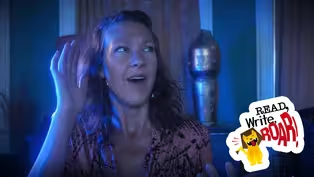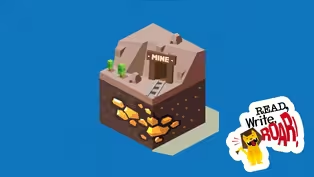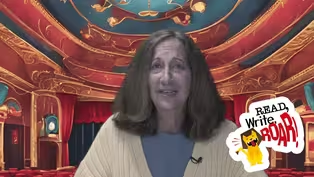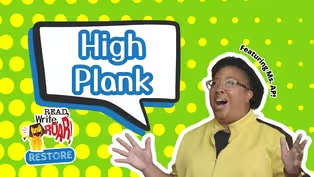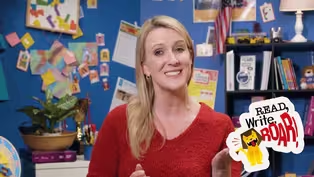Read, Write, ROAR!
Take a Deep Breath
Season 1 Episode 1013 | 26m 45sVideo has Closed Captions
Learn how to create a "found poem" by transforming powerful words in existing texts.
On Read, Write, ROAR! Learn how to create a "found poem" by discovering powerful words in existing texts and transforming them into your own poem. Then, explore the dangers of air pollution and learn how to advocate for cleaner air by writing formal letters to Michigan’s Air Quality Division. Let’s go Read, Write, ROAR!
Problems playing video? | Closed Captioning Feedback
Problems playing video? | Closed Captioning Feedback
Read, Write, ROAR! is a local public television program presented by Detroit PBS
Read, Write, ROAR!
Take a Deep Breath
Season 1 Episode 1013 | 26m 45sVideo has Closed Captions
On Read, Write, ROAR! Learn how to create a "found poem" by discovering powerful words in existing texts and transforming them into your own poem. Then, explore the dangers of air pollution and learn how to advocate for cleaner air by writing formal letters to Michigan’s Air Quality Division. Let’s go Read, Write, ROAR!
Problems playing video? | Closed Captioning Feedback
How to Watch Read, Write, ROAR!
Read, Write, ROAR! is available to stream on pbs.org and the free PBS App, available on iPhone, Apple TV, Android TV, Android smartphones, Amazon Fire TV, Amazon Fire Tablet, Roku, Samsung Smart TV, and Vizio.
Providing Support for PBS.org
Learn Moreabout PBS online sponsorship(upbeat music) - On Read, Write, ROAR!, learn how to create a found poem by discovering powerful words in existing texts and transforming them into your own poem.
Then explore the dangers of air pollution and learn how to advocate for cleaner air by writing formal letters to Michigan's Air Quality Division.
Let's go read, write, roar.
- [Announcer] This program is made possible in part by the State of Michigan and by viewers like you.
Thank you.
(upbeat music) - One of the most important rules for writing poetry is, well, there really aren't any rules.
The great poet Lucille Clifton is known for saying "Poetry is a house with many rooms."
What she means is there are many, many different ways to write poems.
Today we'll learn about a kind of poem where you, the writer, don't even use your own words to write.
Hi everybody, I'm Jeff Kass, and today while we look at how clean air in Michigan is important to our health, we're also gonna experiment with what's known as a found poem, a poem you create from words you find in a work that someone else has written, and it doesn't matter where the words come from, could be a book, a newspaper article, even a magazine.
How can you do this?
Think of yourself as a gold miner except the landscape you're prospecting in in order to unearth the precious metal is a story or an article or even another poem that someone else originally wrote.
What you do is you dig through that piece of writing and look for nuggets of gold, like words that are treasures you can use to write a poem.
Then, once you've found the words you want, you arrange and rearrange them in whatever order you want to make a poem.
You can also use the following techniques to make what you create seem more poetic.
You can use rhythm, that's the beat of flow of words when you read a story or a poem.
You can use repetition, that's using the same words or phrases over and over and over and over and over and over again.
You can use rhyme, when the middle and ending sounds of words are the same.
You know that game.
You can use line breaks where words jump to the next line.
And stanza breaks, a big pause between stances/groups of lines.
Before we can create our found poem, we first need to find the words most critical to the main idea of a piece of writing.
As I read the passage, you'll see the most important words highlighted on the screen.
This is the goal we're digging for to create our poem.
Let me offer a quick example.
Here are two short paragraphs about air pollution.
Air pollution.
Sometimes air pollution is visible.
A person can see dark smoke pour from the exhaust pipes of large trucks or factories, for example.
More often, however, air pollution is invisible.
Polluted air can be dangerous, even if the pollutants are invisible.
It can make people's eyes burn and make them have difficulty breathing.
It can also increase the risk of lung cancer.
Now it's time to dig for gold, I mean words.
I'm gonna go through these paragraphs and highlight the treasures I think I can use in a poem.
I think I can use 'sometimes,' 'air pollution,' 'visible,' definitely 'dark smoke,' 'pour from,' 'exhaust pipes.'
Maybe I can write something about 'large trucks' or 'factories.'
Oh, 'invisible' is good.
'Polluted air' is a key phrase.
'Eyes burn,' 'difficulty breathing,' 'risk,' and 'lung cancer.'
Good.
I think I've found my gold.
Now I'm gonna use these selected words and phrases to create my found poem.
Remember, the goal is to express the same main idea as the original article, and the main idea in the original article seems to be that air pollution, whether it's visible or invisible, is dangerous, so I'm gonna try to write a poem to express that.
So here's my poem.
Air pollution.
Sometimes visible.
Sometimes dark smoke from factories.
Sometimes exhaust pouring from pipes or large trucks.
Sometimes invisible.
Eyes burn, breathing difficult, lungs risk, cancer, visible, invisible, dangerous, dangerous, dangerous.
Does my poem communicate the main idea that air pollution, whether it's visible or invisible, can be dangerous?
(bell ringing) I think it does.
So let's take a closer look at what I did in my writing.
You can see I repeated certain words like 'sometimes' and 'dangerous' to stress their importance.
You can see I move words around.
Notice how I use line breaks and stanza breaks to organize my ideas.
You can see I even changed some words a little like I turned difficulty into difficult and pours into pouring.
I'm not really changing the meaning, just the part of speech so I can keep the flow of my poem.
There's no reason you can't break the rules like that.
You can even add a few other words that aren't in the article if you think you need them.
Remember, poetry is the house with many rules.
That means there's more than one way to write and interpret poetry.
I took the gold I found in the paragraphs, polished 'em up a bit and made a poem.
Now it's your turn.
Find an article about air quality or pollution in Michigan.
Read through it.
Try to decide what you think the main idea is.
Then, highlight words from the article you think you can use in a poem that's gonna express that main idea.
Then take a deep breath, hopefully of clean air and go ahead and find your poem.
Remember, you can include repetition, rhythm, rhyme, line breaks and stanza breaks to make your poem more interesting for your audience.
Have fun.
(upbeat music) - What time is it?
It's time to snag.
It's time for a movement snag.
That's right, with all that brain work, it's time for a reset.
Get ready to restore your energy and rev your brain up.
Let's start moving.
(upbeat music) Miss AP here to help restore your energy.
Before we begin, let's start with our warm up by doing two forward folds.
Stand in your tall mountain, arms up, folding over, feeling that stretch, rolling up.
One last time, arms up, folding over, feeling that stretch, rolling back in to your tall mountain.
Nice job.
Now that we've warmed up our body, we are ready to exercise.
Today we are gonna start on the floor to learn our high plank pose.
Let's start in all fours in our tabletop position, hands and knees to the ground, toes tucked.
We're gonna lower ourselves to the ground, arms shoulder width apart, toes tucked.
Push yourself up.
Hold your position.
Your body is straight like a pencil.
You're gonna lower yourself back down.
You're gonna push yourself back up again.
Hold that position, body straight like a pencil, back down to the ground.
We're gonna modify this high plank, knees to the ground, feet up in the air, hold that position, back down to the ground.
One last time.
Push up.
Keep your arms straight, back down to the ground.
You're gonna push up into your child's pose.
Push yourselves back up in your reset and give yourselves a big clap, clap.
(clapping) Nice job.
Let's cool down by taking two deep breaths.
Deep breath in, deep breath out.
Deep breath in, deep breath out.
Great job.
Wow, that was some awesome work!
You just finished a two minute movement snack to restore your energy.
Now get ready to jump back into learning.
Remember to use the exercise snack we just finished.
To keep moving all day long, (upbeat music) - I am writing a film scene about pollinator gardens and I want to include background sound because even if there aren't people talking in the garden, it is full of sound.
Sometimes media makers call background sound, natural sound or nat sound, but they might also use terms like ambient sound or ambiance as well.
We are going to use the phrase nat sound today.
These words mean sounds which you would expect to hear at that location, like background noise or sounds made by weather.
Nat sound is included to help the viewer feel like they are experiencing the scene with the characters in a fictional film or the participant in a documentary film.
Here are a few examples of nat sound.
If it was a sunny day and you were at a swimming pool, you would expect to hear sounds of children laughing and splashing water.
(children laughing) (water splashing) Now let's listen to the garden.
Do you hear the sounds of the bee moving around the flower?
(bee buzzing) Let's find Miss Kara.
She's watching a film about the March on Washington while also learning about nat sound in documentary filmmaking.
Hello scholars.
It's so good to see you.
I've been viewing the documentary film, Detroit's Walk to Freedom to the March on Washington: 60 Years of Civil Rights Legacy.
This film was produced by One Detroit for Detroit PBS.
While I have been viewing, I've also been listening to all of the extra sounds that were part of the march and which the media maker chose to include in the documentary film.
You see, when a media maker is editing a film, they can include the nat or background sound from the scene they recorded or they can leave it out.
Choosing to leave in or take out the background sound can change the mood, which is the tone or feeling of the film.
Can you imagine watching a film about a Lake Michigan beach and not hearing the waves when they hit the shore?
This is what the film scene looks like without the sound of waves.
(waves crashing) And this is the same scene with the sound of the waves included.
Wow, when the sound is added in, I can really feel the impact of the powerful waves.
The 60th anniversary Walk for Freedom in Detroit was an event which was peaceful as well as one that called for continued activism in support of the Civil rights movement.
(drum beating) In order to help the viewer experience this mood of pride and unity, (marching band playing) the media maker added sounds from a marching band.
We heard the marching band and saw various organizations marching together.
We also heard call and response chants.
- What do we want?
- Freedom.
- When do we want it?
- Now.
- The sounds of the band as well as the chants helped give the viewer an idea of what the mood was like on this day.
It was peaceful and it was also a day the marchers wanted Dr. Martin Luther King Jr's vision to be realized.
Now it's your turn to think about the natural sound you would include in a scene.
If we were at a baseball game, what kinds of sounds would we hear?
I'm thinking about the sound of the crack of the bat hitting the ball and cheers from a crowd.
How about you?
These sounds would help create a different and exciting or energetic mood for that scene.
Natural or nat sound is important in documentary filmmaking because it adds to the mood and makes the film feel more real.
For example, hearing the sounds of birds chirping in a nature documentary can make viewers feel like they're actually in the forest.
These sounds help to create a more exciting experience, making the story more believable for the viewer.
(upbeat music) - Welcome learners.
Before we begin, will you please take a deep breath with me and let it out slowly Ready, (inhaling) and let it out.
(exhaling) What did we just breathe in?
Yes, air, but I wonder if I breathed in anything else like air pollution?
Yuck.
Hi, I'm Mrs. DeFauw.
According to National Geographic, "Air pollution consists of chemicals or particles in the air that can harm the health of humans, animals, and plants.
It also damages buildings."
There are many kinds of pollutants or types of pollution in the air, such as odors, dust, and smoke.
The purpose of today's lesson is to learn about air pollution and craft a professional letter to Michigan's Air Quality Division to thank them for their hard work in keeping our air clean.
Let's read another passage.
According to the Environmental Health Research to Action Foundation, or EHRA, "Air pollution is the main cause of climate change.
As air pollution worsens, the Earth's atmosphere changes.
The greenhouse effect is when heat from the sun is trapped in the Earth's atmosphere due to pollution.
This causes a rise in global temperatures, which leads to changes in climate patterns all over the world."
I learned a lot and to make sure I understand it well, I need to put this in my own words.
Let me model how I'll restate or paraphrase by talking about the topic.
I understand climate change is a huge concern for the entire world.
I didn't know that air pollution is the main cause, so air pollution isn't good for you and me.
It's not good the Earth either because heat from the sun can't escape through pollution.
The National Institute of Environmental Health Sciences stated: "Air pollution is a familiar environmental health hazard," or something dangerous.
"We know what we're looking at when brown haze settles over a city, exhaust billows," that means rises or rolls, "across a busy highway or a plume rises from a smokestack."
Like we see in the image on the webpage.
"Some air pollution is not seen, but it's pungent smell," oh, that's really strong and gross, "alerts you."
Does your brain feel like it might explode after reading all of that information?
Mine too.
So let's work together to talk through what we learned.
Air pollution is?
Yes, dangerous.
Sometimes we can see air pollution and sometimes we can?
Smell it.
When we see air pollution, we might see/ What do you think?
Yes, a brown haze or smoke.
In Michigan we have an Air Quality Division.
When Michigan residents have a concern about air pollution, they may reach out to the Air Quality Division through a survey.
Reading information about air pollution motivates me to take action.
Like author and literacy advocate, Pam Allyn says, "Reading Is Like Breathing In; Writing Is Like Breathing Out."
I breathed in or inhaled by reading more information to understand air pollution.
Now I want to exhale through writing a letter to the Air Quality Division.
I would like to thank them for their impact on the policies that promote clean air.
Let's craft a letter to thank this team for their hard work in keeping our air clean.
Letter writing is a genre or category of writing, so when we think of genres of text, we might think of fantasies, realistic fiction or biographies.
Letters are a type of genre that follows a set of rules.
What are the rules for writing a professional thank you letter?
As the writer or author, I include my professional address in the upper right hand corner.
On the left hand side, I begin with the recipient's address.
For our example, the Air Quality Division is our recipient because they are receiving our letter.
How should we start our letter?
Here's one way we could start the letter.
"Dear Air Quality Division."
Now we think about what we want to say because we've been reading about the topic.
I want the Air Quality Division to know what I learned.
"We've been reading about air pollution.
We learned a lot about the pollution people see and/or smell.
We understand air pollution is very dangerous.
It's a hazard for people, plants, and animals."
Now I think I need to specify some of the hazards.
"Air pollution can make it challenging to breathe.
People, plants, and animals can also get sick from pollutants."
This is a thank you letter and I want to be specific.
"We want to thank you for the work you do to help us to have clean air.
We appreciate how you help businesses to know what they can do better to help air quality.
We also thank you for serving the community through your hard work."
The Air Quality Division does so much to help us and I want to help them too.
What about you?
What could we do?
Let's write a bit more.
"Air quality is so important and all of us must do what we can to not pollute the air.
One step we hope to take is more steps.
We plan to walk more than drive whenever possible."
And now we have to close our letter.
Since we've already said thank you, I'm going to use a different closing.
"Sincerely, Mrs. DeFauw and the Read, Write ROAR!
Learners.
When we read, it's like breathing in that information to feed our brain so we can learn.
When we write about our reading, we exhale all that we've learned through our writing, discussion or reflection.
Air pollution is a very important topic to learn about now so that our future actions can help improve the quality of what we breathe in today and tomorrow.
(upbeat music) (gentle music) - Hello, I'm Miss Audra, and today we're gonna go to outer space.
We know outer space is quiet.
It's silent, but there could be sound in your spaceship or in your spacesuit, so I want you to think about sounds that you can create in your mind.
I want you to hold them.
Maybe you're hearing just your own breath or you're hearing your own heartbeat.
Or maybe you're hearing the roar of the engines or mission control telling you it's safe to land.
So whatever these sounds are little beeps and boops.
But before that, let's take a breath together, a big cleansing breath and we're gonna breathe in together.
Here we go (inhaling) and hold, and blow it out like a space ship.
(exhaling) (blowing) One more deep breath.
(inhaling) Blow it out like a space ship.
(exhaling) (blowing) Nice.
So don't forget you're gonna make a sound.
Whatever you imagine you might hear and make a body movement.
You could just use your hands or your arm or if you have the space, your whole body.
Alright, are you ready?
On the count of three.
I'm gonna listen and then I'm gonna add my sound too.
Alright, here we go.
1, 2, 3.
And I'm gonna add my sound and my movement.
(blowing) Wow.
Think of all the sounds that you heard.
Think about the sound that you made as we built a soundscape for being in outer space in our ship or in our spacesuit.
Let's take a big breath one more time together.
(inhaling) And hold.
Blow it out like a space ship.
(exhaling) (blowing) See you next time.
(upbeat music) - You ever find complicated words when you're reading?
I know I do I. Mrs. Mora.
Today we'll learn to use word parts to read and understand unknown words.
Recently while reading about clean air, I found some difficult words.
Here's one.
First, let's circle the prefixes.
A prefix is a word part added to the beginning of a word to change its meaning.
Do you see any prefixes?
There aren't any.
Next, let's circle the suffixes.
A suffix is a word part added to the end of a word to change its meaning.
Do you see a suffix?
The suffix A-N-T is usually pronounced int.
A-N-T is added to change a verb or an action word into a noun or adjective.
Next, let's mark the remaining vowels.
Vowels help us break words into syllables.
Every syllable has at least one vowel and only one vowel sound.
Which vowels do you see?
We see O and U.
Since there are two vowels, we expect to find two syllables in this part.
Let's split these syllables between the Ls since we often split syllables between double consonants.
Let's say the word parts, pol-lut-ant.
Now, let's say the whole word pullutant.
Is that a real word?
Not quite.
Let's try different sounds to make this a real word.
When I look carefully, I notice the word pollute.
The O is making the schwa sound ah.
And the U says, ooh, because there is a final E at the end of the word pollute.
Let's try those new sounds, pol-lu-tant, pollutant.
That's a real word.
A pollutant is something that pollutes or makes things unclean.
Many air pollutants are invisible.
We don't even know they're around us.
Here's another word.
First, let's circle the prefixes.
Do you see any prefixes?
Here's S-U-S, sus.
Next, let's circle the suffixes.
What do you see?
The suffix I-B-L-E is pronounced ah-bull.
It's related to the suffix, A-B-L-E, and it can mean capable of or tending to.
It's usually added to verbs to form adjectives or describing words.
Now let's mark the remaining vowels.
We see E, which will make the C make the soft sound, ss.
Since there is one vowel, we expect to find one syllable in this root.
Let's say the word parts, sus-cept-ible.
Now, let's say the whole word, susceptible.
Is that a real word?
It is.
Since this is a word we're finished.
Susceptible, describes something likely to be harmed or influenced.
If you have allergies, you might be more susceptible to getting sick from air pollution.
If you speak Spanish, the word, susceptibles, can help you understand this word.
Great work today.
Keep reading and try this strategy the next time you find a challenging word.
- Thank you for watching.
For videos, activity guides and more, please visit our website, MichiganLearning.org.
And don't forget to read, write, roar!
(upbeat music) - [Announcer] This program is made possible in part by the State of Michigan and by viewers like you.
Thank you.
(upbeat music) (soft music)
Video has Closed Captions
Clip: S1 Ep1013 | 2m 30s | Create the sounds of spaceships, mission control, and your own heartbeat in the silence of space. (2m 30s)
Found Poem: Crafting Poetry from Existing Texts
Video has Closed Captions
Clip: S1 Ep1013 | 5m 41s | Use rhythm, repetition, and rhyme, and rearrange the found words to create your own powerful poem. (5m 41s)
How to Add Sound to Your Story
Video has Closed Captions
Clip: S1 Ep1013 | 4m 32s | Explore how background sounds enhance the storytelling experience. (4m 32s)
Pollutant & Susceptible: Decoding Multisyllabic Words
Video has Closed Captions
Clip: S1 Ep1013 | 4m 37s | Explore the secrets of words like "pollutant" and "susceptible" with Mrs. Mora. (4m 37s)
Read, Write, ROAR! Restore - High Plank
Video has Closed Captions
Clip: S1 Ep1013 | 3m 14s | Build strength with Ms. AP as she leads you through the high plank hold in this 2-minute movement s (3m 14s)
Writing to Advocate for Clean Air
Video has Closed Captions
Clip: S1 Ep1013 | 6m 22s | Learn how to advocate for clean air by writing formal letters to Michigan’s Air Quality Division. (6m 22s)
Providing Support for PBS.org
Learn Moreabout PBS online sponsorshipSupport for PBS provided by:
Read, Write, ROAR! is a local public television program presented by Detroit PBS
